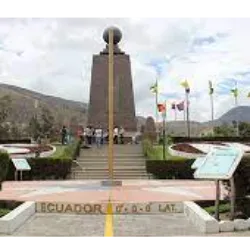Quito, the capital of Ecuador, is the second highest capital city in the world

Quito, the capital of Ecuador, is the second highest capital city in the world, located in the northwest of South America. Founded in 1534 as San Francisco de Quito, the city has around 2.2 million inhabitants. Located at 2,850 meters above sea level, Quito enjoys a constant climate, with temperatures around 21°C throughout the year. The name "Quito" has several interpretations, possibly related to the Tsafiqui language. Cristóbal Cobo led the Quitsato project in 2006, aiming to recover archaeological sites, such as the Catequilla hill, associated with astronomical observations and ancient rituals. The name Quitsato suggests "middle place" and may be related to the Equator line that crosses the place, providing a possible origin for the city's name.
Cotopaxi, the highest active volcano in the world

Cotopaxi, the highest active volcano in the world, stands out in a national park with lakes and Andean animals, and is a tourist attraction about 95 kilometers from Quito. Despite its grandeur and beauty, it is an active volcano, with more than 50 recorded eruptions since 1738. Tourists seek to reach its peak at 5,897 meters above sea level, while Cotopaxi National Park offers several attractions, including rivers, lakes and a variety of fauna . Volcanic activities have been monitored by the Ecuadorian government and universities since the last major eruption in 1904.
Test yourself with one of these challenges 👇
Discover some interesting facts about Ecuador Tourism
Papallacta, at 3,300 meters in the Ecuadorian Andes

Papallacta, at 3,300 meters in the Ecuadorian Andes, is a popular stop for those traveling through the Amazon jungle from Quito. Known for its thermal waters and trout, the city offers spas, restaurants and trails, providing a unique experience with its cold climate contrasting with the thermal waters. Between the Cayambe and Antisana volcanoes, it is a preserved refuge. Thermal waters, ranging from 30°C to 70°C, are recognized for their health benefits, but are not advisable for pregnant women or people with skin problems due to sulfur.
Quilotoa is a crater lake and the westernmost volcano in the Ecuadorian Andes

Quilotoa is a crater lake and the westernmost volcano in the Ecuadorian Andes, formed about 800 years ago by a catastrophic eruption. The caldera, resulting from the collapse of the dacite volcano, houses a 250-meter-deep green lake, with fumaroles at the bottom and hot springs on the eastern flank. Access to the small town of Quilotoa, nearby, is usually via rented truck or bus. Visitors pay an entry fee, and activities include hiking around the caldera. The village of Quilotoa is a starting point for the "Quilotoa Crossing", a multi-day hiking route between villages in the Quilotoa Loop.
Otavalo, two hours from Quito, is an unmissable stop in Ecuador

Otavalo, two hours from Quito, is an unmissable stop in Ecuador, known for hosting one of the largest indigenous fairs in South America and one of the largest open-air markets in the world. Famous for its fabrics and artisanal products, the city offers a unique experience among its stalls. In addition to the busy market, Otavalo stands out for preserving the tradition and cultural richness of the Otavaleños, who share their history and customs. The city also offers attractions such as Laguna Cuicocha, Cascada de Peguche, Laguna San Pablo and the Laguna Mojanda complex, providing visitors with natural beauty and tranquility.
The Jumandy Caves, which are close to the city of Tena

The Jumandy Caves, which are close to the city of Tena, form an impressive complex with golden rocks that resemble animals and saints. About four kilometers deep, the caves contain metals such as tin, silver and gold. According to legend, Jumandy, a local hero, used the caves as a hideout during the Spanish invasion. While exploring the caves, visitors encounter total darkness, bats, waterfalls, lagoons, and a humid environment. Local shamans perform rituals in the caves, which are also known for their medicinal clay. Access is through the jungle of the Jumandy tourist complex, from Tena or Archidona.
Ecuador is a very popular tourist destination in South America

Ecuador is a very popular tourist destination in South America, with a variety of attractions to offer. One of the main tourist attractions is undoubtedly the Galapagos Islands, which are famous for their unique wildlife and have been declared a UNESCO World Heritage Site. In addition, the capital Quito is a historic city with many notable cultural and architectural sites, including the Basilica del Voto Nacional, Palacio de Carondelet and Convento de San Francisco. The country also has a diverse landscape, which includes the Amazon Rainforest, the Andes Mountains and the beaches of the Pacific Ocean. Some of the main tourist attractions include the Yasuní National Park, the city of Cuenca, the ruins of Ingapirca, the Cotopaxi National Park and the Antisana Ecological Reserve. Ecuadorian cuisine is rich in indigenous, Spanish and African flavors and influences. Typical dishes include ceviche, locro de papas, barbecue, empanadas and churros.
Test yourself with one of these challenges 👇
HOME









